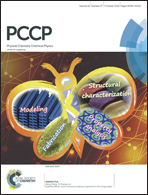On the nature of non-covalent interactions in isomers of 2,5-dichloro-1,4-benzoquinone dimers – ground- and excited-state properties†
Abstract
The competition between non-covalent interactions (NCIs), such as C–H⋯O, C–H⋯Cl, C–Cl⋯O, C–Cl⋯Cl–C, C–O⋯C, C–Cl⋯C and C–O⋯π, in the isomers of the 2,5-dichloro-1,4-benzoquinone (DCBQ) dimer were investigated by quantum chemical calculations to study the properties of the ground and excited states. All the interactions were identified through bond critical points (BCP) with an atoms in molecule (AIM) study. Isomer 1 (IH) and isomer 6 (IP) were surprisingly very stable, and the largest stabilization energies of 4.16 and 5.39 kcal mol−1, respectively, were observed for the ground state and 5.67 and 6.07 kcal mol−1, respectively, were observed for the excited state at the MP2/6-31++G(d,p) level of theory. The orientations of the excited-state isomers were similar to those of the ground-state except for isomer 5 (IX) and isomer 9 (IM), which disturbed the relative energy stability order. The calculated absorption spectra have shown two absorption splits for isomers 5, 7, 8 and 9 through the acute angle between the transition dipole moment of the monomers. The circular dichroism (CD) couplet of the CD spectrum and the value of optical rotation (OR) have indicated that isomers 1, 3, 5, 7, 8 and 9 have chiral characteristics. The study of the absorption and CD spectra has revealed the impact of intermolecular NCIs on chirality.


 Please wait while we load your content...
Please wait while we load your content...